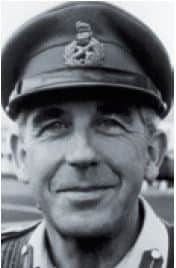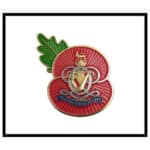After wartime service with the 7th Hussars, covering the long retreat from Rangoon through Burma to India in 1942 and participation in the Allied advance in Italy in 1944-45, Patrick Howard-Dobson rose to command his regiment in the 1960s.

Among his other post-war appointments was his notable period as commandant of the Staff College in the following decade, en route to his final appointment as Vice-Chief of Defence Staff in the early 1980s.
Patrick John Howard- Dobson was the son of Canon Howard Dobson, from whom he inherited his great interest in people, his skill as a communicator and his religious conviction. He had the gift of seeming to give his undivided attention to whomever he was talking to, and he combined this with a great sense of fun, enthusiasm in everything that he undertook and an unfailing memory for faces and names.
It was ironic that when he reached the zenith of his career as a member of the Army Board in 1977, having been the Military Secretary and responsible for the careers of the Army’s commanders and staff officers, it was as Quartermaster-General charged with supplying its material needs. Much to his delight, he was subsequently able to return to the affairs of people as the Vice-Chief of Defence Staff (Personnel and Logistics).
Educated at King’s College Choir School, Cambridge and Framlingham College, Howard-Dobson might have followed his father into the church, but on the outbreak of war he joined the 9th Lancers as a trooper and in May 1941 was commissioned into the Yorkshire Hussars.
He transferred to the 7th Queen’s Own Hussars in the Western Desert in December of that year after Auchinleck’s Crusader offensive, just in time to go with it as part of the 7th Armoured Brigade to the Far East to try to check the Japanese invasion of Burma.
His first battle experience came as a tank troop commander in the grim, 1000-mile withdrawal from Rangoon back into India in 1942, during the last phases of which the 7th Hussars formed part of the rear guard, reaching India on foot, but with their spirit unimpaired.
In 1943 he went with the 7th Hussars back to the Middle East and next saw action with them in Italy in the spring of 1944, when they were supporting the Polish Corps in its advance up the Adriatic Coast and the capture of Ancona. His leadership and gallantry as a troop leader during these operations were recognised by the award of the Polish Vurtuti Militari and the American Silver Star.
The regiment was then re-equipped with amphibious tanks for a rapid advance by the 8th Army intended to cross the great rivers of the Po Valley that autumn, but it was not until the spring of 1945 that this huge manoeuvre was eventually achieved.
In 1950 he attended the Staff College, Camberley, where he made his mark as an able, clear-headed and incisive student, but he is also remembered by his contemporaries for an over-exuberant after-dinner episode in which the cavalry lances, decorating the entrance hall, were flung from the gallery into the oak table below. The repair bill hurt his pocket, but the incident was not held against him: he was back at Camberley as an instructor by the end of the 1950s and was its Commandant in the 1970s.
Command of his regiment came in 1963. By then the 7th Hussars had been amalgamated with the 3rd Hussars to form the Queen’s Own Hussars, whose much respected Colonel he was to become in 1969 – the first member of his regiment to achieve the rank of full General. He commanded them initially in the 20th Armoured Brigade at Detmold, and then as the Armoured Training Regiment in England.
When he relinquished command of his regiment in 1965, he was promoted to Brigadier and returned to Detmold, where he commanded the 20th Armoured Brigade for three years. He then spent a sabbatical in 1968 at the Imperial Defence College before being promoted to Major-General and going out to Singapore as the last Chief of Staff of the British Far East Command. It was his unhappy task to mastermind the mechanics of the last difficult phases of Britain’s withdrawal from South-East Asia.
The smoothness of their execution belied their complexity but reinforced his reputation as an outstanding staff officer as well as an able commander.
He returned from the Far East in 1971 to take over as Commandant of the Staff College, where his ebullient and extrovert personality, his understanding and rapport with people and his abilities as an amusing speaker were great assets. Throughout his career he had thought deeply about military policy, and, for a busy, practical man, he was exceptionally well-read. His years in the highly critical professional environment of Camberley were deemed a great success.
Promoted Lieutenant-General and appointed KCB in 1974, he was equally well chosen for the highly responsible appointment of Military Secretary, whose task it is to advise the Secretary-of-State on the selection of Senior Commanders and Staff Officers.
He was a good judge of people and had the lightness of touch to be able to handle sympathetically the disappointments of those officers whose ambitions were not to be fulfilled.
When he joined the Army Board as Quartermaster-General in 1977, he succeeded a reforming QMG who had been an experienced logistician. Without that background, Howard-Dobson saw his period on the board as one of consolidation, but he was soon thrust into the middle of a Whitehall storm when he
took over as Vice-Chief of Defence Staff (Personnel & Logistics) in 1979.
The economic depression of the early 1980s had resulted in some over-expenditure of defence funds owing to industrial companies with empty order books completing defence contracts far more quickly than expected. It fell to him to grapple with the effects on Service morale of the consequent moratoriums in defence spending and cutbacks in training and military activity generally.
He retired in 1981 and took over as national president of the Royal British Legion almost at once. He found himself faced with morale problems of a different order. The ageing legion membership was in steep decline, and yet a third of the population of the country were ex-servicemen and women and their dependants, who could call upon the legion’s benevolent funds in a time of need.
During his six years as president, he devoted his energies towards revitalising the legion, stepping up its recruiting effort and bringing into the legion (against some internal opposition) serving men and women who, when they left the services, would become the legions welfare workers of the future.
In 1946 he married Barbara (Bar) Mary Mills, who predeceased him. He is survived by two sons and a daughter.
General Sir Patrick Howard-Dobson, GCB, Quartermaster- General of the Army, 1977-79, and National President of the British Legion, 1981-87, was born on August 12, 1921. He died on November 8, 2009, aged 88.



